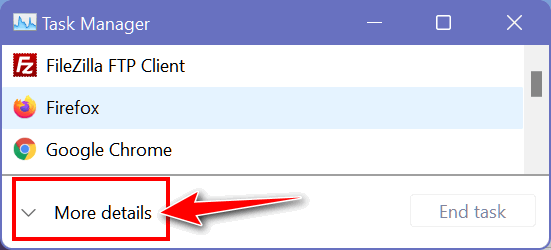The Windows Task Manager
This tip was written for Windows 10 and Windows 11
Windows Task Manager is an extremely useful Windows tool. It’s a great way to find out a lot of info about your PC. If your computer is freezing or hesitating, you can use Task Manager to show you what processes and programs are hogging system resources. You can use Task Manager to stop programs from running at Windows startups, and stop services and open Services.msc. You can use Task Manager to close unresponsive programs. You can use Task Manager to check out suspicious programs and a whole lot more.
There are many ways to open Task Manager, here are a few:
- Right-click on your taskbar and click on Task Manager (Windows 10 Only)
- Press the Ctrl+Shift+Esc keys
- Press Ctrl+Alt+Delete then click on Task Manager
- Windows Key + R. Type TASKMGR and press Enter
- Right-click on the Start button and choose Task Manager.
If you are opening Task Manager for the first time you will have to click “More details” to see all of the details in Task Manager. And you’ll need to do that so you can follow along with this tip 🙂

After clicking “More details” you’ll see Task Manager in all its glory.

You can check your computer’s CPU and RAM usage, by clicking on the Performance tab. In Windows 10 and Windows 11, you can check your startup programs by clicking on the Startup tab.
You can check the status of Windows services. In Windows 10 and Windows 11, you can stop and start services from the Services tab in Task Manager and you can also open Services.MSC from there.

Task Manager allows you to see a list of all processes running on your system. You can sort the list by name, by CPU or RAM usage, and more. When you look at your list of running processes, it may look like you have a whole lot of processes running in the background, even if you don’t have a lot of programs running. In Windows 10 and Windows 11, the number of processes running is shown under the “Processes” tab. They are broken down by category — Apps, Background processes, and Windows processes.
You may notice that the list of processes “jumps” around as you’re looking at it. You can change the speed at which that list refreshes, by clicking View, then “Update speed”. You can slow down or even pause the update speed.

You can right-click on any process to open a menu. From that menu, you can end the task (process) which is helpful if the process is not responding (frozen). You can also open the location of the process, perform an online search to learn more about the process – which can be very helpful if you are suspicious of a certain program or process… and more.

Task Manager is an essential Windows tool you can use to learn more about your computer, diagnose problems, clear up bottlenecks, close non-responding programs, find out what programs are hogging resources, check out suspicious processes, and a lot more.
Open Task Manager and explore. It will expand your Windows world!

